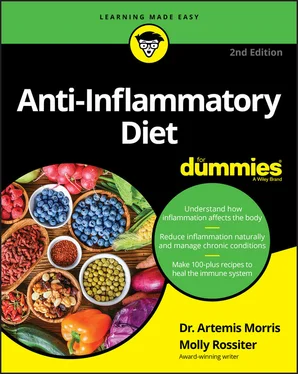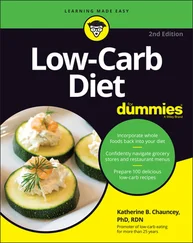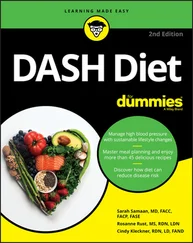Dig in to different food allergies and sensitivities and how your body may be affected without knowing it.
Examine the health benefits of different foods to create a diet that suits your needs.
Make sense of the connection between food and chronic diseases like cancer, heart disease, and neurodegenerative disease.
Chapter 1
Inflammation, Food, and You
IN THIS CHAPTER
 Understanding how inflammation fits into the immune system
Understanding how inflammation fits into the immune system
 Using nutrition to decrease inflammation
Using nutrition to decrease inflammation
 Making lifestyle changes beyond the food you eat
Making lifestyle changes beyond the food you eat
If you ever fell off your bike or out of a tree, you’re familiar with inflammation surrounding an injury. In most cases, inflammation surrounds minor cuts and bruises in the form of swelling and protects the injured area until it heals. Since the late 1980s, however, researchers have turned their attention to other causes of inflammation, such as diet and internal imbalances. These inflammatory responses may be so severe that they lead to chronic illness, such as diabetes, arthritis, heart disease, and cancer.
In this chapter, you get a better idea of just what inflammation is — both the good and the bad — as well as how it’s defined and what to look for. Throughout the remainder of this book, you discover foods that may contribute to the problem as well as those foods, vitamins, and supplements that may lessen the effects of inflammation.
Defining What Inflammation Is
The first thing you need to know about inflammation is that it’s not all bad. In fact, inflammation plays an important role in keeping you healthy. Inflammation is the body’s way of protecting itself from harmful bacteria, viruses, and injury. In some cases, though, that system causes the body to turn on itself, attacking healthy cells and organs. In this section, we take a look at the various kinds of inflammation and identify how things can go wrong.
Understanding how the immune system responds
The immune system is a complicated association of organs, tissues, and cells that work together to protect the body. Inflammation is part of your body’s response when it feels it’s in danger of infection or further injury.
There are three kinds of immunity:
Passive: Passive immunity is a temporary immunity that comes from another body, such as from the mother through the placenta or breast milk. Passive immunity typically disappears 6 to 12 months after birth.
Innate: Innate immunity is the immunity you were born with. Innate immunity includes barriers that keep invaders from entering your body, as well as inflammatory responses — coughing; producing tears, sweat, mucus, and additional stomach acid; swelling; and so on.
Acquired: Acquired immunity develops in the presence of certain antigens. It develops as your body builds defenses against specific invaders, such as viruses that cause chicken pox and the common cold.
In this section, we cover innate and acquired immunity, the two immune systems that stick around through adulthood. We discuss inflammation as part of the innate immune system, and we cover the invader-specific defenses of the acquired immune system.
Innate immunity: Providing general protection with inflammation
Inflammation is part of your body’s innate response to invaders. The inflammatory response takes over when harmful bacteria, viruses, toxins, or other elements make their way into your tissues and cause damage. Those damaged cells release chemicals called prostaglandins and histamines, which cause blood vessels to leak fluid into the tissues and create swelling.
The resulting inflammation — characterized by redness, swelling, heat, and pain — serves as a physical barrier against the spread of infection (in the case of illness) or against further injury (which would delay the healing process). Chemical factors released during inflammation ward off or sensitize pain signals, creating a more suitable environment for healing.
Meanwhile, the immune system, sensing danger, sends backup. Various parts of the immune system respond by directing traffic, isolating and killing the invaders, and destroying and clearing out infected cells. The cells communicate with each other through a variety of chemical signals, including cytokines, C-reactive protein, acute-phase proteins, prostaglandins, and more. Understanding this response is helpful for doctors because inflammatory markers indicate where the problem is and how severe it may be. Researchers examine the process to determine what triggers inflammation and find ways to control it — such as through diet — when things go wrong.
Acquired immunity: Attacking specific invaders from past encounters
The acquired, or adaptive, immune system is the one you develop based on what you do, where you go, and what you’re exposed to. The more bugs and viruses you come in contact with, the more complex your acquired immune system becomes and potentially the more protected.
Through a process called immune response, the immune system calls upon its network — cells, tissues, and organs — to combat illness and infection. Leukocytes , or white blood cells, seek out and destroy infectious organisms and substances. There are two kinds of leukocytes:
Phagocytes, which are the hungry leukocytes that eat the invaders
Lymphocytes, which help the body identify and recognize attackers so it knows what to watch for later
Here’s what happens: When your body detects antigens (the foreign substances), a group of cells get together and form a type of cell army to attack the invader. Some of these cells produce antibodies that can lock onto the specific antigens. The antibodies serve as tags, identifying the invader as an enemy and targeting it for destruction.
Some of the antibodies continue to live in your body so they can immediately attack if the same antigen is detected. The next time the antibodies encounter that antigen, they lock on and initiate an inflammatory response.
Seeing where inflammation goes wrong
When inflammation works right, it attacks the irritant — the virus, harmful bacteria, or damaged cells. Sometimes, however, the body kicks into overdrive and launches an offensive on normal, healthy tissue. For example, if you have the autoimmune disorder rheumatoid arthritis, you see some redness and some swelling in the joints, with joint pain and stiffness. This reaction is a sign that your body is trying to attack your joint tissue, which your body mistakenly perceives as unfriendly.
Say your house is being overtaken by mosquitoes. You get some mosquito spray, light a citronella candle, and keep a rolled-up newspaper handy. You’re handling the irritant and the irritant only. Now say you’ve gone a little bit overboard. Instead of a rolled-up newspaper, you take a baseball bat and try to kill that mosquito on the wall. The problem is that the mosquito wasn’t a mosquito at all; it was just a shadow, and now you have a hole in the wall. In the same way, the immune system can overreact to perceived threats and damage the body.
The way your body responds to inflammation partially depends on your genetics and environmental factors. Most generally healthy people respond to a cut or bruise in the same way, but how the immune system responds to a virus, a bacteria, or different foods can differ from person to person. The differences in the way your immune system responds depends on the following:
Читать дальше

 Understanding how inflammation fits into the immune system
Understanding how inflammation fits into the immune system










